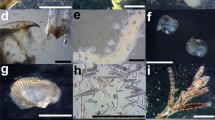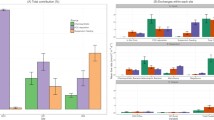Abstract
A newly described species of shrimp, Rimicaris exoculata Williams and Rona, 1986, dominates the megafaunal community at two hydrothermal vent sites on the Mid-Atlantic Ridge. Behavioral observations and gut-content analyses indicate, that these shrimp ingest large amounts of sulfide particles from black smoker chimneys. We found no evidence for chemoautotrophic endosymbionts in R. exoculata, based on analyses of morphology, stable isotopes, lipopolysaccharides, and ribulose-1,5-bisphosphate carboxylase (RuBPCase) activity. Instead we suggest that the shrimp, are normal heterotrophs, grazing on free-living microorganisms associated with black smoker chimneys. We infer that high bacterial productivity is required to sustain populations of R. exoculata at these vent sites.
Similar content being viewed by others
Literature cited
Baross, J. A., Deming, J. W. (1985). The role of bacteria in the ecology of black-smoker environments. Bull. biol. Soc. Wash. 6: 355–371
Cavanaugh, C. (1983). Symbiotic chemoautotrophic bacteria in marine invertebrates from sulphide-rich habitats. Nature, Lond. 302: 58–61
Cavanaugh, C. M., Gardiner, S. L., Jones, M. L., Jannasch, H. W., Waterbury, J. B. (1981). Prokaryotic cells in the hydrothermal vent tube worm Riftia pachyptila Jones: possible chemoautotrophic symbionts. Science, N.Y. 213:340–342
Dall, W., Moriarty, D. (1983). Functional aspects of nutrition and digestion. In: Mantel, L. H. (ed.) The biology of Crustacea, Vol. 5. Academic Press, New York, p. 215–261
Detrick, R. S., Honnorez, J., Adamson, A. C., Brass, G. W., Gillis, K. M., Humphris, S. E., Mevel, C., Meyer, P. S., Petersen, N., Rautenschlein, M., Shibata, T., Staudigel, H., Wooldridge, A., Yamamoto, K. (1986a). Mid-Atlantic bare-rock drilling and hydrothermal vents. Nature, Lond. 321: 14–15
Detrick, R. S., Honnorez, J., Adamson, A. C., Brass, G. W., Gillis, K. M., Humphris, S. E., Mevel, C., Meyer, P. S., Petersen, N., Rautenschlein, M., Shibata, T., Staudigel, H., Yamamoto, K., Wooldridge, A. (1986b) Drilling the Snake-Pit hydrothermal sulfide deposit on the Mid Atlantic Ridge, lat. 23°22'N. Geology (Boulder, Colorado) 14: 1004–1007
Edmond, J., Campbell, A. C., Palmer, M. R., Klinkhammer, G. P. (1986). Preliminary report on the chemistry of hydrothermal fluids from the Mid-Atlantic Ridge. EOS Trans., Am. geophys. Un. 67: p. 1021
Felbeck, H. (1981). Chemoautotrophic potential of the hydrothermal vent tube worm, Riftia pachyptila Jones (Vestimentifera). Science, N.Y. 213: 336–338
Felgenhauer, B. E. Abele, L. G. (In press). Evolution of the foregut in the lower Decapoda. In: Felgenhauer, B. E., Watling, L., Thistle, A. D. (eds.) Feeding and grooming structures of selected Crustacea. Crustacean issues, Vol. 6. A. A. Balkema, Rotterdam
Fry, B. (1986). Increases in 15N and 13C as measures of food web structure in an offshore fishery. EOS Trans., Am. geophys. Un. 67: p. 988
Fry, B., Gest, H., Hayes, J. M. (1983). Sulphur isotopic compositions of deep-sea hydrothermal vent animals. Nature, Lond. 306: 51–52
Fry, B., Sherr, E. B. (1984). δ13C measurements as indicators of carbon flow in marine and freshwater ecosystems. Contr. mar. Sci. Univ. Tex. 27: 13–47
Grassle, J. F. (1986). The ecology of deep-sea hydrothermal vent communities. Adv. mar. Biol. 23: 301–362
Grassle, J. F., Humphris S. E., Rona, P. A., Thompson, G., Van Dover, C. L. (1986). Animals at Mid-Atlantic Ridge hydrothermal vents. EOS Trans., Am. geophys. Un. 67: p. 1022
Hobbie, J. E., Daley, R. J., Jasper, S. (1977). Use of Nuclepore filters for counting bacteria by fluorescence microscopy. Appl. envirl Microbiol. 33: 1225–1228
Huber, H., Huber, G., Stetter, K. O. (1985) A modified DAPI fluorescence staining procedure suitable for the visualization of lithotrophic bacteria. Syst. appl. Microbiol. 6: 105–106
Jannasch, H. W. (1985). The chemosynthetic support of life and the microbial diversity at deep sea hydrothermal vents. Proc. R. Soc. (Ser. B) 225: 277–297
Jannasch, H. W., Wirsen, C. O. (1981) Morphological survey of microbial mats near deep-sea hydrothermal vents. Appl. envirl Microbiol. 41: 528–538
Karl, D., Wirsen, C., Jannasch, H. (1980). Deep-sea primary production at the Galapágos hydrothermal vents. Science, N.Y. 207: 1345–1347
Minagawa, M., Wada, E. (1984). Stepwise enrichment of 15N along food chains: further evidence and the relation between 15N and animal age. Geochim. cosmochim. Acta 48: 1135–1140
Minagawa, M., Winter, D., Kaplan, I. R. (1984). Comparison of Kjeldahl and combustion methods for measurement of nitrogen isotope ratios in organic matter. Analyt. Chem. 56: 1859–1861
Miyake, Y., Wada, E. (1967). The abundance ratio of 15N/14N in marine environments. Rec. oceanogr. Wks Japan 9: 37–53
Rau, G. H. (1982). The relationship between trophic level and stable isotopes of carbon and nitrogen. In: Bascom, W. (ed.) Coastal water research project, biennial report, 1981–1982. Southern California Coastal Water Research Project, Long Beach, California, p. 143–148
Rau, G. H. (1985). 13C/12C and 15N/14N in hydrothermal vent organisms: ecological and biochemical implications. Bull. biol. Soc. Wash. 6: 243–247
Rees, C. E., Jenkins, W. J., Monster, J. (1978). The sulphur isotopic composition of ocean water sulphate. Geochim. cosmochim. Acta 42: 377–381
Rona, P. A. (1985). Black smokers and massive sulfides at the TAG hydrothermal field, Mid-Atlantic Ridge 26°N. EOS Trans., Am. geophys. Un. 66: p. 936
Rona, P. A., Klinkhammer, G., Nelson, T. A., Trefry, J. H., Elderfield, H. (1986). Black smokers, massive sulphides and vent biota at the Mid-Atlantic Ridge. Nature, Lond. 321: 33–37
Schroeder, B., Thompson, G., Humphris, S. E., Sulanowska, M. (1986). Hydrothermal mineralization, TAG area, Mid-Atlantic Ridge 26°N. EOS Trans., Am. geophys. Un. 67: p. 1022
Smith, K. L. (1985). Macrozooplankton of a deep-sea hydrothermal vent: in situ rates of oxygen consumption Limnol. Oceanogr. 27: 461–471
Sulanowska, M., Humphris, S. E., Thompson, G., Schroeder, B. (1986). Hydrothermal mineralization in the MARK area, Mid-Atlantic Ridge, 23°N. EOS Trans., Am. geophys. Un. 67: p. 1214
Thompson, G., Humphris, S. E., Rona, P. E. (1986). Hydrothermal precipitates from a black smoker vent, TAG area, Mid-Atlantic Ridge 26°N. A. Mtg geol. Soc. Am. Abstr. 18: p. 772
Watson, S. W., Novitsky, T. J., Quinby, H. L., Valois, F. W. (1977). Determination of bacterial number and biomass in the marine environment. Appl. envirl Microbiol. 33: 940–946
Williams, A. B. (1987). More records for shrimps of the genus Rimicaris (Decapoda: Caridea: Bresiliidae) from the Mid-Atlantic Rift. J. Crustacean Biol. (Lawrence, Kansas) 7: p. 105
Williams, A. B., Rona, P. A. (1986). Two new caridean shrimps (Bresiliidae) from a hydrothermal field on the Mid-Atlantic Ridge. J. Crustacean Biol. (Lawrence. Kansas) 6: p. 446–462
Yanagisawa, F., Sakai, H. (1983). Thermal decomposition of barium-sulfate-vanadium pentaoxide — silica glass mixtures for preparation of sulfur dioxide in sulfur isotope ratio measurements. Analyt. Chem. 55: 985–987
Author information
Authors and Affiliations
Additional information
Communicated by P. C. Schroeder, Pullman
Rights and permissions
About this article
Cite this article
Van Dover, C.L., Fry, B., Grassle, J.F. et al. Feeding biology of the shrimp Rimicaris exoculata at hydrothermal vents on the Mid-Atlantic Ridge. Mar. Biol. 98, 209–216 (1988). https://doi.org/10.1007/BF00391196
Accepted:
Issue Date:
DOI: https://doi.org/10.1007/BF00391196




